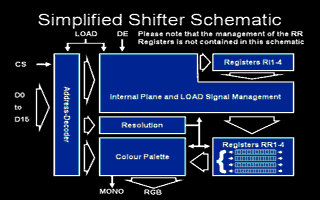Overscan
Techniques
Part II
The internal structure of the SHIFTER:
As the GLUE controls the DE signal, one would expect the
beginning of the useable screen to always occur at the same
location on the screen. However, if one removes the right
border, one will see that the useable screen starts slightly
further to the left than it does in the normal non-overscan
mode. The SHIFTER is responsable for this effect. Unlike the
GLUE, it is a complex circuit. Providing a full explanation of
its function is beyond the scope of this article. Instead I
present here a simplified explanation, which may describe
certain aspects poorly, but suffices for this study.

The SHIFTER contains 4 16-bit registers RR1 to RR4, where RR
denotes Rotating Register. Each of these registers undergoes a
continuous rotation, shifting out their most significant bit on
each rotation. The most significant bits thus output are used to
address colours in the palette which is directly linked to the
RGB pins. For instance in low resolution, the four RR registers
are shifted so 4 bits are output at a time, corresponding to the
4 bitplanes. Thus, after 16 rotations, RR1 to RR4 are "empty".
The four RR registers are updated simultaneously and at the same
time, whatever the resolution. Consider medium resolution. It
only uses 2 bitplanes, so only two registers RR1 and RR2 are
being shifted. It doubles the horizontal resolution (640
pixels), so both registers are rotating twice as fast as in low
resolution. Each time the RR registers are shifted, their least
significant bit is cleared. Once RR1 and RR2 have been
"emptied", they are updated with the contents of RR3 and RR4,
which are themselves emptied.
High resolution is processed slightly differently: only RR1
rotates, but at four times the speed it does in low resolution.
The exiting bit addresses bit 0 of colour 0 in the palette to
determine whether the picture should be shown in inversed video.
It is also reinserted as the entering bit of RR1, so RR1 is
rotated rather than shifted. When RR1 has been emptied, it is
updated with the value of RR2; RR2 is updated with the value of
RR3 and RR4 with that of RR3. RR4 is then empty, and is filled
with $0000 or $FFFF depending on the value of bit 0 of colour 0.
The SHIFTER also contains four temporary bitplane registers: IR1
to IR4, where IR denotes Internal Register. Their behaviour is
given by the following pseudo-code:
Number_of_read_bitplanes = 0
REPEAT
IF Load is active THEN IR[Number_of_read_bitplanes] = Data sent from MMU
Number_of_read_bitplanes = Number_of_read_bitplanes + 1
IF Number_of_read_bitplanes == 4 AND IF DE is active
THEN RR1 = IR1; RR2 = IR2; RR3 = IR3; RR4 = IR4
IF Number_of_read_bitplanes == 4 THEN Number_of_read_bitplanes = 0
END_REPEAT
This process is continuous, and depends in no way on the
synchronisation signals sent by the GLUE. Thus the RR registers
are only reset when four bitplanes were received. As the RR
registers are permanently rotated, they are emptied when the MMU
sends no data or when DE (Display Enable) is off. In low and
medium resolutions, each shift fills the least significant bit
with a zero, which explains why the border colour is determined
by colour zero in the palette. In high resolution they are
filled by the value of bit 0 of colour 0 (signal BE)
guaranteeing that the border is always black. This avoids the
use of the Blank signal when the monitor's electron gun returns
to the next line. This can be verified by causing the SHIFTER to
display something during this time: it is displayed as a
diagonal trace on the screen (it is extended and grey rather
than white as the electron beam is moving quickly).
Note that every change of resolution immediately changes the
SHIFTER's behaviour: RR1 to RR4 will be treated differently, and
any momentary switch to high resolution will appear as a black
line on a colour monitor and a horizontal line on the monochrome
monitor. This corresponds to a temporary disactivation of the
RGB pins and the activation of the Mono pin. If transition
occurs during the useable screen, the effect obtained differs on
STF's and STE's, and differs according to the exact position on
the screen in which it occured. For instance, there is a
position from which a black line will extend all the way to the
extreme right of the screen. This corresponds to the activation
of the BLANK signal by the GLUE. These effects do not change the
way in which the screen is decoded, or the synchronisation
signals are generated.

|



